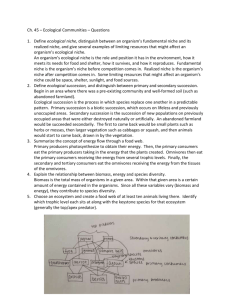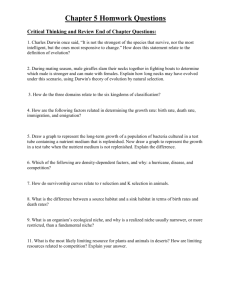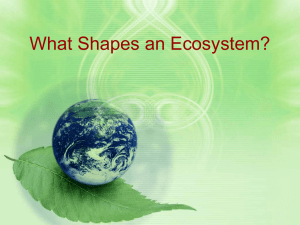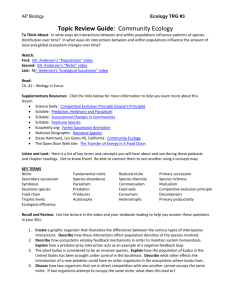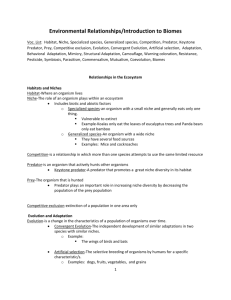Chapter 4
advertisement
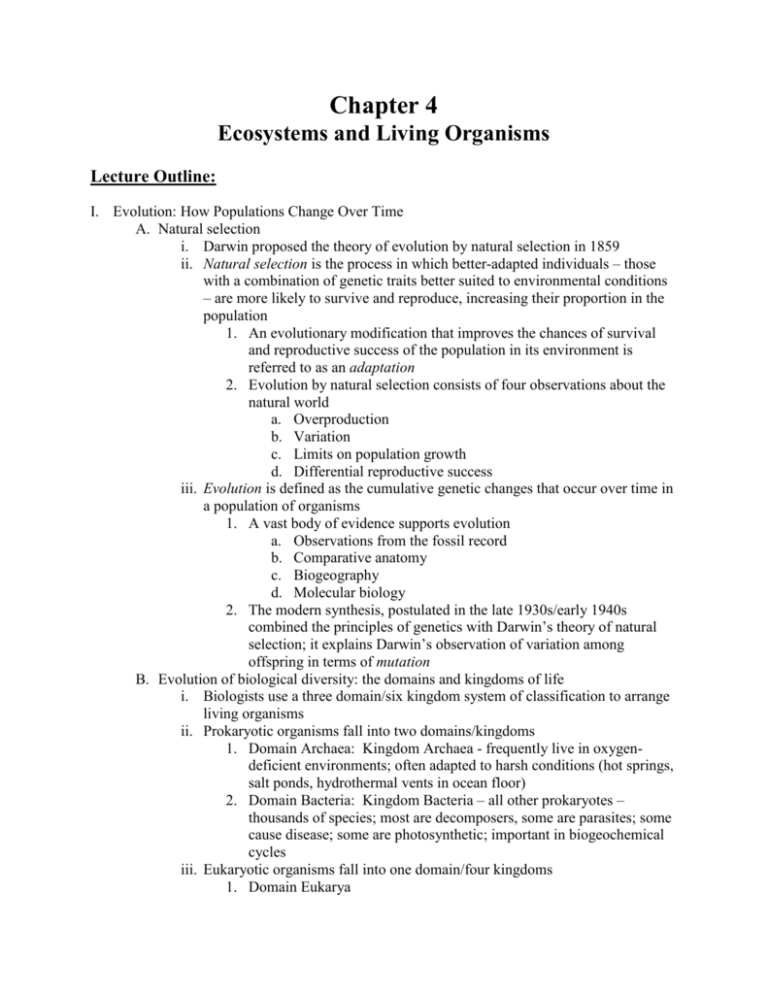
Chapter 4 Ecosystems and Living Organisms Lecture Outline: I. Evolution: How Populations Change Over Time A. Natural selection i. Darwin proposed the theory of evolution by natural selection in 1859 ii. Natural selection is the process in which better-adapted individuals – those with a combination of genetic traits better suited to environmental conditions – are more likely to survive and reproduce, increasing their proportion in the population 1. An evolutionary modification that improves the chances of survival and reproductive success of the population in its environment is referred to as an adaptation 2. Evolution by natural selection consists of four observations about the natural world a. Overproduction b. Variation c. Limits on population growth d. Differential reproductive success iii. Evolution is defined as the cumulative genetic changes that occur over time in a population of organisms 1. A vast body of evidence supports evolution a. Observations from the fossil record b. Comparative anatomy c. Biogeography d. Molecular biology 2. The modern synthesis, postulated in the late 1930s/early 1940s combined the principles of genetics with Darwin’s theory of natural selection; it explains Darwin’s observation of variation among offspring in terms of mutation B. Evolution of biological diversity: the domains and kingdoms of life i. Biologists use a three domain/six kingdom system of classification to arrange living organisms ii. Prokaryotic organisms fall into two domains/kingdoms 1. Domain Archaea: Kingdom Archaea - frequently live in oxygendeficient environments; often adapted to harsh conditions (hot springs, salt ponds, hydrothermal vents in ocean floor) 2. Domain Bacteria: Kingdom Bacteria – all other prokaryotes – thousands of species; most are decomposers, some are parasites; some cause disease; some are photosynthetic; important in biogeochemical cycles iii. Eukaryotic organisms fall into one domain/four kingdoms 1. Domain Eukarya Chapter 4 a. Kingdom Protista – unicellular or relatively simple multicellular organisms, (i.e., algae, protozoa, slime molds, and water molds); important in aquatic food chains; algae are important producers b. Kingdom Plantae – complex multicellular, most use radiant energy to manufacture food molecules by photosynthesis; play important role as producers and source of atmospheric oxygen c. Kingdom Fungi – most are complex multicellular, secrete digestive enzymes into their food and then absorb the predigested nutrients; decomposers; some are parasites; some cause disease d. Kingdom Animalia – complex multicellular, ingest their food and then digest it inside their bodies; consumers-herbivores, carnivores, omnivores, and detritivores II. Biological Communities A. A biological community and its abiotc environment comprise an ecosystem i. A community is an association of different populations of organisms that live and interact in the same place at the same time ii. Unraveling of the many positive and negative, direct and indirect interactions of organisms living as a community is one of the goals of community ecologists B. Succession: how communities change over time i. Succession is the process of community development over time, in which species in one stage are replaced by different species ii. Primary succession occurs when the change is species composition over time takes place in a previously uninhabited environment 1. Recently formed volcanic lava and rock scraped clean by glaciers represent previously uninhabited environments 2. The initial community that develops during primary succession is termed a pioneer community 3. Primary succession takes hundreds or thousands of years to occur iii. Secondary succession begins in an environment following destruction of all or part of an earlier community 1. Abandoned farmland and open areas caused by forest fires are common examples of secondary succession sites 2. Each stage of succession supports its own characteristic animal life III. Interactions Among Organisms A. Symbiosis defines any intimate relationship or association between members of two or more species i. The partners of a symbiotic relationship are termed symbionts ii. Thousands, even millions, of symbiotic associations that result from coevolution fall into three categories 1. Mutualism - both partners benefit (+,+) 2. Commensalism – one organism benefits and the other one is neither harmed nor helped (+,0) 50 Chapter 4 3. Parasitism – one organism benefits and the other is adversely affected (+,-) a. When a parasite causes disease and/or death of a host, it is known as a pathogen b. Parasitism is a successful lifestyle; more than 100 parasites live in or on the human species alone B. Predation is defined as the consumption of one species (the prey) by another (the predator) i. Includes both herbivore-carnivore interactions and producer-herbivore interactions ii. Predation has resulted in an evolutionary “arms race” with the coevolution of predator and prey strategies 1. Pursuit and ambush 2. Plant defenses against herbivores 3. Defensive adaptations of animals C. Competition occurs when two or more individuals attempt to use an essential common resource such as food, water, shelter, living space, or sunlight i. Intraspecific competition occurs among individuals within a population ii. Interspecific competition occurs between species IV. The Ecological Niche A. The ecological niche is defined as the totality of an organisms adaptations, its use of resources, and the lifestyle to which it is fitted i. An ecological niche is basically determined by all a species’ structural, physiological, and behavioral adaptations ii. It includes the local environment in which an organism lives, its habitat, as well as the abiotic components of its environment (i.e., light, temperature, moisture) 1. The potential, idealized ecological niche of an organism is its fundamental niche 2. The lifestyle an organism actually pursues and the resources it actually uses make up its realized niche B. Limiting resources i. Any resource at a suboptimal level relative to an organism’s need for it or at a level in excess of an organism’s tolerance for it is a limiting resource ii. Limiting resources restrict the ecological niche of an organism, and often affect only one part of an organism’s life cycle C. Competitive exclusion and resource partitioning i. The idea of competitive exclusion holds that no two species indefinitely occupy the same niche in the same community due to competition between species; however, coexistence can occur if the overlap in the two species niches is reduced ii. Competition has an adverse effect on all species that use a limited resource iii. In resource partitioning, coexisting species’ niches differ from each other in one or more ways (i.e., timing and/or location of feeding, nest sites, etc.) V. Keystone Species 51 Chapter 4 A. A keystone species is a species, often a predator, that exerts a profound influence on a community in excess of that expected by it s relative abundance B. Keystone species are vital in determining the nature and structure of the entire ecosystem VI. Species Richness A. Species richness is defined as the number of species in a community B. Important factors determining species richness include: the abundance of potential ecological niches, closeness to the margins of adjacent communities, geographic isolation, dominance of one species over others, habitat stress, and geologic history i. Species richness is usually greater at the margins of adjacent communities than in the centers 1. Species richness is usually greater at the margins of adjacent communities than in their centers a. An ecotone is the transitional zone where two or more communities meet b. Ecotones contain all or most of the ecological niches of the adjacent communities as well as some niches unique to the ecotone 2. The change in species composition produced at ecotones is known as the edge effect ii. Species richness is inversely related to the environmental stress of a habitat iii. Species richness, ecosystem services, and community stability 1. Conservationists maintain that ecosystems with greater species richness better supply ecosystem services than ecosystems with lower species richness 2. Ecosystem services are important environmental benefits that ecosystems provide to people (i.e., clean air, water and fertile soil) 3. Community stability, the ability of a community to withstand environmental disturbances, is also thought to directly correlate with community complexity 52 Chapter 4 In-Class Activities: Instructor Notes for In-Class Activity 1 Title: Producer, Consumer…Predator, Prey Time: Materials: Handouts: 5 minutes prep; 20 – 30 minutes in class None Enough copies of each handout for everyone in the class. Procedures: Divide class into 3, 6, 9 etc. groups of two to five people. Have them organize into clusters of three groups; for each cluster, assign one group to be producers, one to be the consumers/prey, and one to be predators. Each group will read its group’s description. Next, each group will make one small change to its description: 1. The producer group should make a small change that helps it avoid the consumer. 2. The consumer will make one small change to EITHER better get the producer or better avoid the predator. 3. The predator will make one small change to better catch the prey The groups should then reveal their changes, and discuss how this impacts each of the three. Repeat this process at least three times, each time reacting to the new situation. Then have all the groups describe the “new” plants / creatures they have found, paying attention to a) how different they have become over time and b) how different the driving forces were. You will be assigned as a producer, consumer/prey or predator in a Student Instructions: simple ecosystem. You will then have the opportunity to make one small change that improves your chances vis a vis whatever eats you and or is eaten by you. At the same time, the other creatures/plant will be changing. You will repeat this several times, and at the end will compare your “evolved” plant / creature to the original, as well as to groups “evolving” in parallel to yours. Note that you need not only make “reactive” changes; you may also make more “cooperative” changes. Specific Suggestions: None Objectives: Describe producer, consumer, predator and prey relationships Describe the process of natural selection. Define production, consumption and predation 53 Chapter 4 In-Class Activity 1: Handout Original animal descriptions Producer. You are a small plant that grows in some shade. You grow quickly into a small, stocky shape, and have some short spines to limit the extent to which your consumer can eat you. Consumer/Prey You have a short snout that means that you can eat part of the producer, but cannot eat too deeply into the delicious fleshy part because you get poked by the spikes. You can run short distances quickly into a small hole to avoid the predator; you curl into a hard-to-see ball if it gets too close. Predator You catch the prey by sneaking up quickly. You only see it well when it is moving. When it runs, you need to catch it fast; you are too small to get into its lair, and it is a quick escape artist. 54 Chapter 4 Instructor Notes for In-Class Activity 2 Title: Designing a Closed Aquarium Time: Materials: Handouts: 5 minutes prep; 20 – 30 minutes in class None None Procedures: None Normally, when people design aquaria, they expect to provide a variety Student Instructions: of inputs. These include energy (food), air (bubblers), temperature and chemical control, and occasional cleaning. It is possible, however, to design a “closed” aquarium, provided that it has an external source of light. Working in groups of 3-4, draw and describe a simple “closed” aquarium. This will require at minimum a producer and a decomposer, but that would be rather boring. Include at least one primary consumer. Explain what role each organism will perform. What do you think will be the biggest threat to the system’s stability? If you were to get the system to work for a year, do you think it will change over time? Why and in what way? Choose one member of you group to report back to the class. Discuss how your group’s aquarium differs from that of another group. Finally, get back together with your group and discuss whether you can improve your design. Specific Suggestions: None Objectives: Describe how producers, consumers and decomposers interact in a closed system. 55 Chapter 4 Instructor Notes for In-Class Activity 3 Title: Exploring Niches on Campus Time: Materials: Handouts: 0 – 30 minutes prep; Full class period. None None Procedures: Most campuses harbor any number of species. A few of these may have been in place before the campus opened. Most, however, have either moved in or have adapted substantially to the campus setting. First, have students develop lists of aspects of niches. Next, have them tour your campus (or other suitable location), looking for animals and plants that live there. Have students take notes on the niches of one or more of these animals. Pay particular attention to 1. Living space 2. Predators (if any…look up, you may find birds of prey!). Sources of protection from prey 3. Sources of food Return to class and compare notes. Discuss: How have animals adapted to life on campus? How similar / different do you think species interactions are to / from conditions before the campus was opened? First, create a list of items or conditions associated with an organism’s Student Instructions: niche. Next, explore your campus, looking for plants and animals that live there (these may or may not be intentionally maintained). Take notes on the niches of these plants or animals Return to class, and discuss how animals have adapted to these niches. In what ways are they similar to or different from “natural” settings? Specific Suggestions: None Objectives: Describe the factors that contribute to an organism’s ecological niche. 56 Chapter 4 Instructor Notes for In-Class Activity 3 Title: Humans in Ecological Relationships Time: Materials: Handouts: 5 minutes prep; 15 – 25 minutes in class. None None Procedures: Have students describe, in ecological terms, our relationships with each of the following: • Potatoes • Aphids • Weeds • Shade Trees • Cockroaches • Lawns • Honeybees • Beef cattle • Dairy cattle Use this as a springboard to discuss ecological relationships, and the challenges are advantages to thinking about human-environment relationships in ecological terms. Describe, using ecological terminology, human relationships with each of Student Instructions: the following: • Potatoes • Aphids • Weeds • Shade Trees • Cockroaches • Lawns • Honeybees • Beef cattle • Dairy cattle Which of these fit cleanly into one of the categories typically used by ecologists? Specific Suggestions: Objectives: What are the implications of this for “sustainability” None Explain ecological terms for interactions among organisms Describe interactions among humans and other organisms in ecological terms 57 Chapter 4 Instructor Notes for In-Class Activity 4 Title: Succession Time: 5 minutes prep; 60 minutes out of class time and 5 minute per group presentation time None None Materials: Handouts: Procedures: Dive the students into teams and have them search the internet for “Succession Pictures”. Each team should come up with at least three different succession pictures. Have them put them into a power point presentation and present to the class. As a team you are to surf the internet and look for three different types Student Instructions: of “Succession Pictures”. Put them in a power point presentation and make sure you reference them and title them according to the succession. A minimum of 10 slides per power point. Optional activity Suggestion: Instead of a power point presentation all the pictures can be brought to the class and a calendar for a year can be made with the pictures. If some students brought in winter type pictures they could be used for the winter months etc. This calendar could be displayed throughout the year using the succession pictures. Objectives: Explain the process of succession as it deals with the environment. Describe the process of succession and how communities change over time. 58 Chapter 4 Answers to Thinking About the Environment End of Chapter Questions: 1. During mating season, male giraffes slam their necks together in fighting bouts to determine which male is stronger and can mate with females. Explain how long necks may have evolved under this scenario, using Darwin's theory of evolution by natural selection. Ans: Darwin recognized that, from one generation to the next, inherited traits favorable to survival in a given environment would be preserved, whereas unfavorable ones would be eliminated. The result would be adaptation, evolutionary modification that improves the chances of survival and reproductive success of the population in its environment. If male giraffes with long necks gained more mates they would leave more offspring, thereby, increasing the number of long necked giraffes in the population. 2. Describe an example of secondary succession. Begin your description with the specific disturbance that preceded it. Ans: Answers will vary. Disturbance may be a fire or abandoned farmland. Secondary succession on abandoned farmland in the southeastern United States proceeds in this sequence: crabgrass → horseweed → broomsedge and other weeds → pine trees → hardwood trees. 3. What type of symbiotic relationship—mutualism, commensalism, or predation—do you think exists between the pygmy seahorse and the gorgonian coral pictured in Figure 4.12? Explain your answer. Ans: The pygmy seahorse and the gorgonian coral live in a commensalism. A commensalism is a type of symbiosis in which one organism benefits and the other one is neither harmed nor helped 4. Biologists recognize that the three types of symbiosis are not always clearcut. For example, under certain conditions mutualism may become commensalism or even parasitism. What type of symbiosis is it if the fungi in mycorrhizae take so much of their host's food that the host cannot reproduce? Explain your answer Ans: If the fungi consume so much food that the host cannot reproduce then the relationship becomes parasitic. A parasitism is a symbiotic relationship in which one organism benefits and the other is adversely affected. 5. How are symbiosis and predation related to the concept of energy flow through ecosystems that was covered in Chapter 3? Ans: Predation transfers energy form a lower trophic level to a higher trophic level. Energy is transferred when animals eat other animals (for example, herbivore-carnivore interactions) and when animals eat plants (producer-herbivore interactions). The transfer of symbiotic relationships will vary depending on the nature of the relationship; in a mutualism energy may flow back and forth between the symbionts, in a commensalism no energy flow may take place, and in a parasitism energy is only flowing in one direction. 59 Chapter 4 6. Why is a realized niche usually narrower, or more restricted, than a fundamental niche? Ans: The potential, idealized ecological niche of an organism is its fundamental niche, but various factors such as competition with other species usually exclude it from part of its fundamental niche. The lifestyle an organism actually pursues and the resources it actually uses make up its realized niche. Put differently, an organism is potentially capable of using much more of its environment's resources or of living in a wider assortment of habitats than it actually does. 7. What portion of the human's fundamental niche are we occupying today? Do you think our realized niche has changed over the past 200 years? Why or why not? Ans: Answers will vary 8. Explain how fundamental and realized niches apply to the rodents in the Chihuahuan desert of Arizona. Ans: In one experiment, the scientists enclosed their study areas with fencing and then cut holes in the fencing to allow smaller rodents to come and go but to exclude the larger kangaroo rats. The removal of three dominant species, all kangaroo rats, from several plots resulted in an increased diversity of other rodent species. This increase was attributed to less competition for food and to an altered habitat, because the abundance of grass species increased dramatically after the removal of the kangaroo rats. By removing the kangaroo rats the realized niches of the other smaller rodents increased because direct competition from kangaroo rats was removed. 9. What is the most likely limiting resource for plants and animals in deserts? Explain your answer. Ans: Most limiting resources that scientists have investigated are simple variables such as the mineral content of soil, extremes of temperature, and amount of precipitation. Such investigations have disclosed that any resource that exceeds an organism's tolerance or is present in quantities smaller than the minimum required limits the occurrence of that organism in an ecosystem. 10. Which study discussed in this chapter is a classic example of competitive exclusion? Ans: The initial evidence that competition between species determines an organism's realized niche came from a series of experiments conducted by the Russian biologist G. F. Gause in 1934. Gause grew populations of two species of Paramecium (a type of protist), P. aurelia and the larger P. caudatum. When grown in separate test tubes, the population of each species quickly increased to a high level and remained there for some time. When grown together, only P. aurelia thrived; P. caudatum dwindled and eventually died out. Under different environmental conditions, P. caudatum prevailed over P. aurelia. Gause concluded that one set of conditions favored one species and a different set favored the other. Nonetheless, because both species were so similar, given time, one or the other would eventually triumph in a mixed culture. 60 Chapter 4 11. Which study discussed in this chapter is a classic example of resource partitioning? Ans: Resource partitioning may include timing of feeding, location of feeding, nest sites, and other aspects of an organism's ecological niche. Robert MacArthur’s study of five North American warbler species is a classic example of resource partitioning. 12. Some biologists think that protecting keystone species would help preserve biological diversity in an ecosystem. Explain. Ans: Keystone species, are vital in determining the nature and structure of the entire ecosystem—that is, its species composition and its ecosystem functioning. For this reason, identifying and protecting keystone species are crucial goals of conservation biologists because if a keystone species disappears from an ecosystem, many other organisms in that ecosystem may become more common, rare, or even disappear. 13. Diagram the food web discussed in the Environews on the acorn-Lyme disease connection. Ans: Answers will vary 14. John Muir once said, “Tug at a single thing in nature, and you will find it connected to the universe.” Explain this quote using the acorn-Lyme disease connection discussed in the chapter. Ans: This quote reminds us now interconnected natural systems are. If one aspect of a system is altered it affects the whole system. In the example of the acorn-Lyme disease connection scientist have shown that it is possible to predict which years pose the greatest threat of Lyme disease to humans, based on when oaks are most productive. The oaks provide food for the mouse populations, which also feed on moth pupae, this in turn helps the oaks avoid predation and attracts tick-bearing deer. The ticks feed on mice and the ticks often carry Lyme disease which may be transmitted to humans. No one part of this system is isolated from another part. 15. Draw a diagram of three concentric circles and label the circles to show the relationships among species, ecosystems, and communities. If you were adding symbiosis, predation, and competition to the simple system you have depicted, in which circle(s) would you place them? Ans: Answers will vary Answers to Review Questions Evolution: How Populations Change Over Time (p. 68) 1. What are Darwin's four premises of evolution by natural selection? Ans: Natural selection, as envisioned by Charles Darwin, has four premises: 1. Each species produces more offspring than will survive to maturity. 61 Chapter 4 2. The individuals in a population exhibit inheritable variation in their traits. 3. Organisms compete with one another for the resources needed to survive. 4. Those individuals with the most favorable combination of traits are most likely to survive and reproduce, passing their genetic characters on to the next generation. Biological Communities (p. 73) 1. What is ecological succession? Ans: Ecological succession is the orderly replacement of one community by another. 2. How do primary and secondary succession differ? Ans: Primary succession is the change in species composition over time in a previously uninhabited environment. Secondary succession is the change in species composition that takes place after some disturbance destroys the existing vegetation; soil is already present. Interaction Among Organisms (p. 79) 1. What is symbiosis? What are the three kinds of symbiosis? Ans: Symbiosis, any intimate relationship or association between members of two or more species, includes mutualism, commensalism, and parasitism. Mutualism is a symbiotic relationship in which both partners benefit. Commensalism is a type of symbiosis in which one organism benefits and the other one is neither harmed nor helped. Parasitism is a symbiotic relationship in which one organism benefits and the other is adversely affected. 2. What is predation? Describe how evolution has affected predator-prey relationships. Ans: Predation is the consumption of one species (the prey) by another (the predator). During coevolution between predator and prey, the predator evolves more efficient ways to catch prey, and the prey evolves better ways to escape the predator. 3. What is competition? What are the two main kinds of competition? Ans: Competition is the interaction among organisms that vie for the same resources (such as food or living space) in an ecosystem. Competition occurs among individuals within a population (intraspecific competition) or between species (interspecific competition). The Ecological Niche (p. 82) 1. What is an ecological niche? 62 Chapter 4 Ans: An organism's ecological niche is the totality of its adaptations, its use of resources, and the lifestyle to which it is fitted. 2. What are limiting resources? How might a limiting resource affect a species' ecological niche? Ans: A limiting resource is any environmental resource that, because it is scarce or at unfavorable levels, restricts the ecological niche of an organism. 3. What is the principle of competitive exclusion? resource partitioning? Ans: Many ecologists think no two species occupy the same niche in the same community for an indefinite period. In competitive exclusion, one species excludes another as a result of competition for limited resources. Some species reduce competition by resource partitioning, in which they use resources differently. Keystone Species (p. 83) 1. What is a keystone species? Why is the wolf considered a keystone species? Ans: A keystone species is a species, often a predator, that exerts a profound influence on a community in excess of that expected by its relative abundance. The wolf is considered a keystone species because in areas where wolves were hunted to extinction, the populations of elk and other herbivores increased. As these herbivores overgrazed the vegetation, many plant species disappeared. Many smaller animals such as insects were lost because the plants they depended on for food were now less abundant. Thus, the disappearance of the wolf resulted in an ecosystem with considerably less biological diversity. Species Richness (p. 86) 1. What are two determinants of species richness? Give an example of each. Ans: Several factors appear to be significant in determining species richness, the abundance of potential ecological niches, closeness to the margins of adjacent communities, geographic isolation, dominance of one species over others, habitat stress, and geologic history. For example, in a study of chaparral habitats (shrubby and woody areas) in California, those with structurally complex vegetation provided birds with more kinds of food and hiding places than communities with low structural complexity. 2. What are ecosystem services? Describe some ecosystem services a forest provides. Ans: Ecosystem services are important environmental benefits that ecosystems provide, such as clean air to breathe, clean water to drink, and fertile soil in which to grow crops. 63

